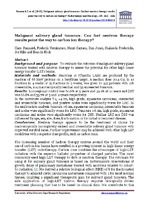| dc.description.abstract | BACKGROUND AND PURPOSE: To evaluate the outcome of malignant salivary gland tumours treated with neutron therapy to assess the potential for other high linear energy transfer (LET) beams.
MATERIALS AND METHODS: Neutrons at iThemba LABS are produced by the reaction of 66 MeV protons on a beryllium target. A median dose 20.4 Gy, in 12 fractions in 4 weeks or 15 fractions in 5 weeks, was given to 335 patients with 176 irresectable, 104 macroscopically residual and 55 unresected tumours.
RESULTS: Locoregional control was 60.6% at 5 years and 39.1% at 10 years and DSS was 66.8% and 53.7% at 5 and 10 years respectively.
In the univariate analysis T4, >4 cm, high grade, squamous carcinoma, unresected and irresectable tumours, and positive nodes were significantly worse for LRC. In the multivariate analysis tumours >6 cm, squamous carcinoma, irresectable tumours and nodes were significantly worse for LRC. Tumours >6 cm, high grade, squamous carcinoma and nodes were significantly worse for DSS. Neither LRC nor DSS was influenced by age, sex, site, dose, fractionation or for initial or recurrent disease.
CONCLUSIONS: Neutron therapy appears to be the treatment of choice for macroscopically incompletely excised and irresectable salivary gland tumours with improved survival rates. Further improvement may be achieved with other high LET modalities with a superior dose profile, such as carbon ions. | en_US |

